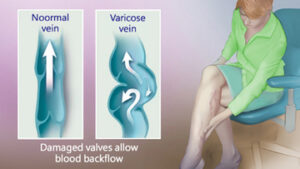 If you suffer from varicose veins, then you do have options. You can opt to have them surgically removed. The large, bulging bluish veins can occur on the legs and thighs. They often cause chronic pain and discomfort if not treated. In this article, we will explore varicose vein surgery as a form of treatment.
If you suffer from varicose veins, then you do have options. You can opt to have them surgically removed. The large, bulging bluish veins can occur on the legs and thighs. They often cause chronic pain and discomfort if not treated. In this article, we will explore varicose vein surgery as a form of treatment.
What are Varicose Veins?
A varicose vein occurs when the valve inside the vein fails which keeps the blood from flowing up to the heart. Instead, it pools inside of the vein causing it to become swollen and can become painful to the touch.
 During pregnancy, it is not uncommon to develop varicose veins. However, they many times these varicose veins can go away once the baby is delivered. – Aging, standing for long periods of time and other factors all cause varicose veins. It does not have to be directly linked to pregnancy.
During pregnancy, it is not uncommon to develop varicose veins. However, they many times these varicose veins can go away once the baby is delivered. – Aging, standing for long periods of time and other factors all cause varicose veins. It does not have to be directly linked to pregnancy.
Other causes of varicose veins:
- Family history
- Obesity
- Sex (being born female)
Varicose Vein Stripping
Varicose vein stripping is a surgical procedure that is often called ablation, avulsion, or ligation. With vein stripping, the large vein (superficial saphenous) is tied off to treat the varicose veins. The procedure is undertaken using general anesthesia or spinal anesthesia. With general anesthesia, you fall asleep and with a spinal only the lower half of your body is numb, so you stay awake for the whole surgery.
Why Undergo Varicose Vein Stripping?
If you suffer from varicose veins, then you should consult with your doctor to determine the best treatment option. Varicose vein stripping is usually done in the following cases:
- Chronic and unrelenting pain
- Throbbing
- Tenderness
- Bleeding
- Blood clots
- Cosmetics
Varicose Vein Stripping
If you have made the decision to undergo varicose vein stripping, then you are probably wondering what you can expect during the surgery.
- Step One: The surgeon will make two or three small incisions in your leg. The incisions are made in the region of the top, middle, and bottom of the varicose vein. An incision can also be made in your groin and then lower on your leg by either your ankle or calf.
- Step Two: A thin, plastic wire is threaded through the vein via the groin incision. It is worked down towards the incision on your ankle or calf. The vein can then be pulled out.
- Step Three: Smaller cuts are made over the smaller veins and they are then either removed or tied off. Such a procedure for smaller veins is referred to as ambulatory phlebectomy.
- Step Four: The incisions are then sewn shut.
- Step Five: You must wear bandages or compression stockings following the procedure.
If you have recently undergone vein stripping, your physician may require you to use compression stockings after the procedure. It is best to get this from a licensed professional and this way you can ensure the correct size and strength of the garment. A compression garment that is too short does not help you so that is why a licensed orthotist can help you get what you need for compression therapy.
Fore more information, please check out our other blog posts on vein related issues.
